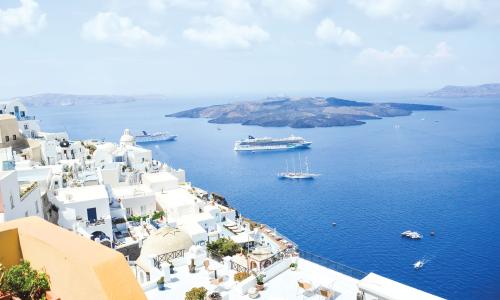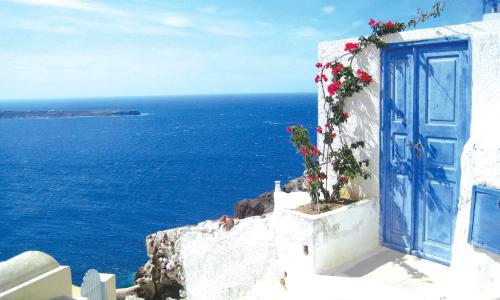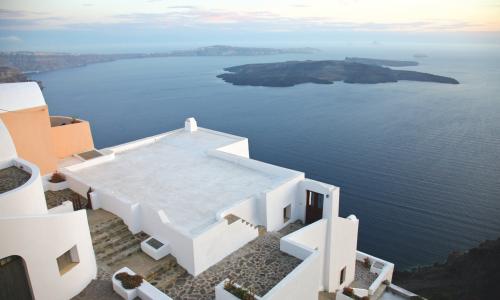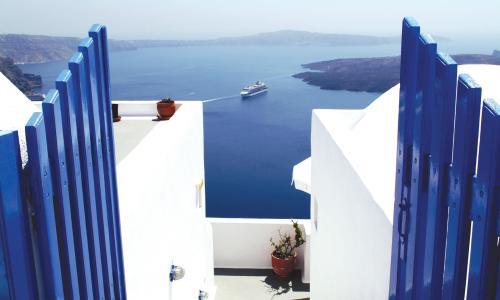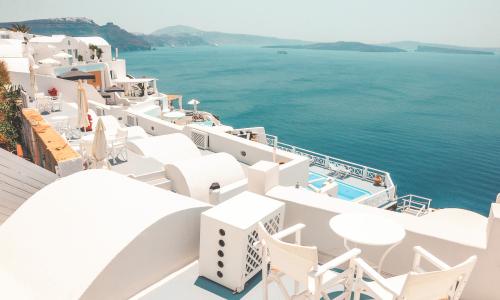(Area: 76 sq km - Coastline: 69 km - Distance from Piraeus: 130 n.m.)
Santorini or Thera (Thira in Greek) is one of the most spectacular and best-known of the Greek islands. It is the most southerly island of the Cyclades, lies between Ios and Anafi, and differs from the other Cycladic islands thanks to its wild beauty and geological morphology, the result of action by a volcano now dormant.
Santorini’s striking landscape, its peculiarities of the natural environment, its outstanding monuments, and the legend of Atlantis attract very large numbers of visitors.
The island is commonly known by two names: the Venetian “Santorini” (after the 3rd c. AD Santa Irini who died in exile on the island) or its ancient name of “Thira” (now reinstated as its official name). In antiquity it was called “Strongyli” (round) or “Kallisti” (most beautiful) and was first settled by Phoenicians. The archaeological finds have revealed that it was inhabited since prehistoric times (5th millenium BC) and flourished during the Early Cycladic period (3200-2100 BC). The digs at Akrotiri have shown that the island was still flourishing in the Middle Cycladic period (2100-1550 BC). All its prosperity came to an end with the eruption of the volcano about 1500 BC. In about 1000 BC Dorian colonists settled in the island which, after their leader, took the new name “Thira”.
Santorini is the largest fragment of a volcanic archipelago made up of the broken remnants of the largest caldera (crater) on earth and now thought by many to be the origin of the Atlantis legend; when the inpouring of the sea into the caldera during a massive eruption about 1500 BC gave the impression that the greater part of the island had sunk. Within the caldera subsequent volcanic eruptions (the last 12 August 1925) have spawned new islets of lava.
Santorini’s landscape is mostly volcanic. In the hinterland is the mountain of Profitis Ilias (island summit 565 m). On the western side of the island there are cliffs, while on the eastern side there is a large fertile valley and vast beaches. Some of the most spectacular beaches can be found on Santorini: some with dark pebbles and others with black sand.
The main ferry terminal is at Athinios, the only one of Santorini’s three ports with a road link, which lies on the west coast, 7 km S of the capital Fira or Thira that is built along the upper slopes of the west coast. From the old island port, Fira Bay or Skala, one can climb up to Fira on foot or on donkey-back. There is a cable-car for those who wish to avoid the 587 steps. Fira is very attractive, with bright white houses clinging to the cliff sides of the Caldera, winding narrow streets, arcades, and a quarter where the Catholic nobility once dwelt. There is a superb view out from Fira to the Kamenes (burnt ones), the two coal coloured islets Nea Kameni and Palia Kameni, that can be visited by tour boats which depart from one of the three island’s ports (Fira Bay, Athinios and Oia). To the north-west of Fira and in a distance of 1 km is Firostefani, a village with a magnificent view of the sea, and 2 km further at an altitude of 300 m is Imerovigli, a traditional village with panoramic views of the Aegean and unique sunsets. 4 km to the east of Imerovigli is another interesting traditional village, Vourvoulos. 10 km NW of Fira is the traditional village of Finikia and 0.5 km further there is a place of incomparable beauty, Oia, a village with old-world charm and offering breathtaking views of sunsets and sea. The unique appeal of Oia lies in its little houses hewn out of the soft rock (some of them whitewashed, others painted blue or ochre), its neoclassical mansions with their courtyards, and its narrow paved alleys.
Among the interesting villages and resorts on Santorini are also: Emboreio, an inland village 8 km S of Fira, which was fortified in the medieval times. Kamari, a modern resort on the east coast, 8.5 km SE of Fira, with a vast sandy beach. Karterados, an inland village about 2 km SE of Fira. Megalohori, a traditional village 5.5 km S of Fira and 5 km from Athinios. Messaria, a village surrounded by vineyards and orchards, 3 km SE of Fira. Monolithos, a resort on the east coast, near the airport and 7 km E of Fira. Perivolos, a resort on the south-east coast, about 10.5 km S of Fira. Perissa, a cosmopolitan resort on the east coast, 10.5 km SE of Fira, famous for its vast black sandy beach. Pyrgos, a large inland village built on the slopes of Mt. Profitis Ilias, 4.5 km SE of Fira, offering a panoramic view of the whole island.
Historic sites and monuments: Akrotiri Archaeological Site (Tel. 22860 81366) on the south coast, the remains of a prospering Minoan city (complete with its own drainage system) in the 16th c. BC, destroyed around 1500 BC by an eruption of the volcano on Thira. Ancient Thira (7th c. BC-2nd c. AD), an archaeological site (Tel. 22860 22217) at an altitude of 396 metres on the slopes of Mt. Messa Vouno to the north of Perissa. Remains of an ancient cemetery at the locality “Koloumbo” to the north-east of Finikia, as well as remains of ancient houses in the sea. Remains of a small ancient temple (3rd c. BC) at Megalohori. The Venetian castle “Skaros” (built in 1207) very close to Imerovigli. The convent of Aghia Ekaterini (1596) in Fira. The monastery of Aghios Nikolaos (1674) between Firostefani and Imerovigli. The church of Panayia “tou Kalou” (1650) at the village of Pori on the east coast. The church of Panayia “Platsani” at Oia. The Byzantine church of Theotokaki (10th c.) at Pyrgos. The monastery of Timios Stavros (19th c.) at Perissa. The Byzantine church of Episkopi (11th c.) at the village Messa Gonia near Kamari. The monastery of Profitis Ilias (1711) on the top of Mt. Profitis Ilias, 4 km SE of Pyrgos. The churches of “Issodia tis Theotokou”, Aghii Anargyri and Aghios Nikolaos “Marmaritis” at Megalohori. The churches of Panayia “stin Trypa” (in a rock) and Aghia Anna at the village of Vothonas, 2 km to the south-east of Messaria.
Museums: Prehistoric Museum of Thira and Archaeological Museum (Tel. 22860-22217, 23217) in Fira. Thira Nautical Museum (Tel. 22860-71156, 71271) in Oia. Megaron Gyzi (Tel. 22860 23077) in Fira. Folklore Museum Lygnou (Tel. 22860 22792) in Kontohori-Fira. Nautical Museum (Tel. 22860 71156) housed in Birbilis Mansion (Arhontiko) in Oia. Traditional Neoclassical House “Arhontiko Argyrou” (Tel. 22860 31669) in Messaria. Ecclesiastical & Folklore Museum in the monastery of Profitis Ilias.
Beaches: Ammoudi, Armeni, Athinios Bay, Baxedes, Exo Gialos, Kamari, Kokkini Ammos, Monolithos, Paralia Vourvoulos, Perissa.
Sports: Water Sports, Walking.
Traditional tastes: Wine of several types. Fava (a type of pulses). Fried white aubergines.
